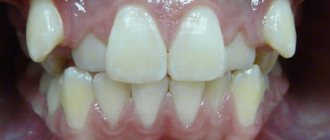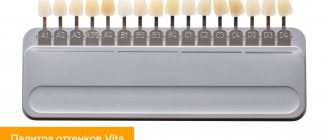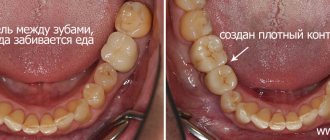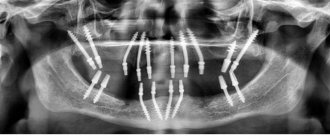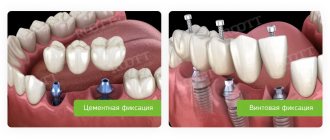01.12.2019
Single crowns and bridges are permanent prostheses that can hide significant deficiencies of natural but damaged teeth or replace their crown part. During operation, such products have their own characteristics, one of which is difficulty in washing them and surrounding tissues.
To facilitate hygienic care, the dentist makes a small temporary gap between the gum tissue and the marginal line of the crown during the prosthetic process. The prosthetic indentation is called flushing. Due to various factors, the tolerance for liquid may increase, food particles may get into it, which over time leads to complications and the development of complex diseases. About 20% of patients suffer from problems with the flushing space. What are the causes of such pathologies and how to eliminate them, we will consider in this article.
REASONS FOR THE APPEARANCE
Most often, the space between the crown and gum increases due to medical errors during prosthetics. When the prosthesis is pressed strongly against the surface of the tooth or if it is not firmly placed on the base, an unacceptable gap size appears between the gum and the masking product.
However, in some cases the problem does not arise through the fault of the doctor.
Unpleasant phenomena develop against the background of pathological processes in the patient’s oral cavity:
- Inflammation of the interdental papillae, gums and degenerative processes in the periodontal tissues. Such problems with oral health often develop when the body's protective properties are weakened, which is accompanied by allergies and inflammatory reactions to poor hygiene.
- Loss of tightness of the elements that firmly fix the removable device in the oral cavity.
- Splitting of the bridge in the area of contact with artificial crowns. If the denture has been damaged even slightly, it will inevitably change its correct position and have a detrimental effect on the tissues surrounding the tooth.
- Disintegration of a single crown. This happens if the device was installed incorrectly or when saliva gets under the crown.
- Poor oral hygiene causes inflammation of the gum tissue with swelling, which will change the size of the rinsing gap.
- Poor quality of preparation before prosthetics. Insufficient sanitation of the oral cavity, poor strength of hard and soft tissues lead to gradual destruction of the protective layer of teeth. The orthopedic device begins to settle, thereby lifting the gum above the crown.
- Periodontal disease and periodontitis. Such diseases lead to changes in the position of individual teeth, which, by their displacement, increase the size of the washing gap.
- The patient's attempts to clean the interdental space with toothpicks or other sharp objects. After such procedures, the gap between the denture and the tooth increases, food begins to get stuck and becomes a provocateur for the proliferation of pathogenic microorganisms.
- The fixing composite composition has become unusable. After the expiration of the dental cement with which the fixation was made, the crown moves away from the tooth, creating a space for food to enter. It gradually rots and thereby causes an inflammatory process.
- Excessive chewing loads on the structure. Strong pressure on the crown leads to its breakage. It happens that a tooth breaks along with the product, and it is almost impossible to save it after that.
Remember! The fit of the structure to the teeth should be optimal. That is, too tight contact or insufficient fit is unacceptable.
In the first case, such an installation can result in trauma to the tissues and mucous membranes of the mouth, in the second, the fixation of the structure is weakened, which threatens negative changes in pronunciation and difficulties in the process of eating.
Such defects very quickly disable the prosthesis without the possibility of its restoration and bringing it into working condition.
During the period of adaptation after installation of the orthopedic structure, the special gap between it and the gum should normally increase slightly. However, after 7 days of recovery, the gap width should become smaller if the patient has cared for the area properly.
Reviews
Although dental prosthetics is one of the most ancient techniques used in dentistry, during the period of its existence some problems that arise after the installation of the structure have not been eradicated.
The formation of a gap between the gum and the crown is a fairly common problem that patients have to face today.
However, if a problem is detected in a timely manner, it can be easily eliminated in the shortest possible time, the main thing is to consult a doctor in time.
Have you encountered such a problem? If yes, we ask you to leave your feedback in the comments, describing your method of eliminating such an unpleasant incident that causes grief.
If you find an error, please select a piece of text and press Ctrl+Enter.
Tags crown prosthetics
Did you like the article? stay tuned
FIRST SIGNS
The optimal flushing gap (norm of a fraction of a millimeter), when installed correctly, ensures:
- proper fixation of the device;
- high-quality hygiene;
- protection against manifestations of pathologies of periodontal tissues;
- long-term operation of the product.
Normally, this temporary effect should not cause any complications.
You should be concerned after installing a prosthesis in the following cases:
- discomfort appears and pain occurs in certain areas of the oral cavity;
- the structure has changed its position in the mouth and this is noticeable;
- increased sensitivity of tissues and teeth to irritating foods (cold, hot, spicy, salty) and temperature changes;
- bothered by itching and burning;
- manifestations of a lisp develop;
- a whistle is heard from the mouth during a conversation;
- The general condition of the oral cavity is only getting worse every day.
The listed undesirable manifestations can be observed at the site of localization of the orthopedic product or beyond.
If the first symptoms appear, it is important to immediately seek help from a specialist.
If you have any mistrust in your dentist or orthopedist, you can get alternative advice and assistance at another medical institution.
Increasing the flushing space
When the permissible level of space is exceeded, the edge of the gum recedes from the prosthesis by 2-5 mm, in especially severe cases - by a greater distance. The gap gradually increases in size if therapeutic action is not taken. The following symptoms are possible:
- blue or reddening of the gum edge,
- sensation of itching in the pathological area,
- constant pressure of the crown on the gum or food caught in the rinse on the gum,
- pressure on the tongue
- poor fit of the prosthesis up to its protrusion from the general row of teeth.
POSSIBLE COMPLICATIONS
If you ignore the problems that have arisen and do not visit a doctor in time for an examination, as well as to identify the causes of the gap, the patient risks encountering serious troubles and complications, namely:
- development of complex inflammation in periodontal tissues;
- sudden dismantling of the entire structure;
- destructive diseases of the units located under the crowns;
- allergy attacks to prosthetic material;
- complete breakdown of the device in the area adjacent to the crowns;
- the appearance of excessive galvanic currents in the oral cavity;
- increase in electrical conductivity of saliva;
- the appearance of signs of inflammation of the mucous membrane;
- relapses of carious processes;
- development of general symptoms of unwellness of the body;
- erosive and ulcerative lesions of the mucous membrane;
- atrophy of the tissues holding the tooth in the alveolus.
Take into account! If, after installing a crown, you are constantly bothered by painful sensations in the mouth for more than 7 days, the crown periodically moves, senesthopathy, burning, tingling in a certain area appears, the sensitivity of the teeth to irritating foods increases, you cannot do without medical help.
Moreover, the listed manifestations can be localized not only in the area of the installed device.
Another important danger that can arise after prosthetics is the penetration of the prosthesis into the digestive system after unexpected release.
Despite the fact that such products are made from non-toxic raw materials, the risk of damage to internal organs remains. Let's consider the most serious consequences, which, although rare, occur in medical practice:
- perforation of the walls of the digestive tract;
- trauma to the stomach or intestines with subsequent bleeding;
- intestinal obstruction if the swallowed product has formed an obstruction with its body.
In such cases, it is very important to immediately go to the hospital or call an ambulance. An acute clinical picture of this nature requires examination by a surgeon, gastroenterologist, or emergency transportation of the patient to the nearest emergency room.
ELIMINATION TACTICS
Any specialist in the dental niche, providing his services, is obliged to create an ideal fit of the orthopedic structure on the bed. That is, even if minor changes occur in the distance between the device and the working surface, the gap should remain at the optimal permissible width.
It is also important to take into account the fact that any foreign body in contact with organs and tissues of the body can initially cause discomfort, which normally can last no more than one week.
If, after this period, the body continues to signal with unpleasant symptoms, then this is a good reason to seek medical help.
If the gap between the crown and the gum has widened beyond normal limits, doctors solve the problem in the following ways:
- Local anti-inflammatory and antiseptic treatment is carried out by treating damaged areas with gels, ointments and other effective means. In this case, the structure itself is first removed from the oral cavity.
- The dental device is adjusted and adjustments are made to its parameters. If the product is unsuitable, the doctor decides to make a new design. Before this, it is important to obtain orthopantomogram data.
- The orthopedist can grind and adjust the prosthesis right in his office when the patient contacts him. All actions are performed depending on the clinical picture.
If the problem lies in the loosening of problem units, they are strengthened. After this, the prosthetics are repeated.
The rarest occurrence is the peeling of the structure when it comes to a bridge. The trouble is accompanied by a change in the position of the supporting units, which results in the need for re-prosthetics.
To avoid this, you need to go to the clinic where the installation procedure was carried out on the same day and eliminate any existing defects and defects.
Attention! Installation of crowns is permanent prosthetics. Therefore, it is not possible to simply remove the device and rinse it under clean running water or clean it using special products and return it to its place.
If the gap has increased, it means that it is urgently necessary to take measures to normalize its size.
Mechanical enlargement of the gap has one solution - reinstallation of the prosthesis. The specialist dismantles the system for correction or completely replaces it, after carrying out health measures and following a competent algorithm of actions during installation.
What to do if the tooth under the crown has completely rotted
It happens that a tooth rots because the crown was initially installed on a defective stump. And sometimes the person himself is to blame for this development of events, because he delayed contacting the doctor.
If the tooth has at least its roots preserved, it is possible to restore the tooth with a special device - a stump insert. The structure is made of ceramic or metal and has branches according to the number of roots. These processes are fixed in the root canals to a third of their depth. The top of the stump tab is intended to strengthen the crown on it.
Often gold or silver is used to cast the stump insert. The first material is preferable because it shines through the crown with a warm yellow color. This shade is similar to the color of natural enamel and is not perceived as foreign. The silver tab has antibacterial properties, but the cold shade affects the visual pigmentation of the gums. This will bother the patient, especially if the tooth is located in the front.
If the roots are rotten, the stump insert will not hold in them. The remaining tooth is removed and restored with an implant or prosthetics.
If the adjacent teeth, which will play the role of supporting teeth, are preserved, it is possible to install a fixed bridge prosthesis. Removable dentures are also common: nylon, acrylic. Here you will have to focus on the amount that the patient is able to pay for this or that method of dental restoration, and the aesthetics that he prefers. During the consultation, the doctor will offer to look at the options for finished products in the photo, and the person will choose the appropriate type of product.
PREVENTION MEASURES
To prevent problems with the crown from occurring, the patient must strictly follow the medical recommendations that are communicated to him immediately after the prosthetic procedure:
- perform high-quality hygienic care for the product, organs and tissues of the oral cavity at least 2 times a day;
- Use herbal rinses and dental hygiene devices for additional cleansing 3 times a week;
- periodically visit the attending physician for a preventive examination, monitoring the condition of the structure, and its professional cleansing of food particles;
- use a special dental brush to remove the smallest food residues after each meal;
- use wound-healing pastes for prevention if the slightest discomfort occurs (especially during the period of adaptation);
- purchase an adhesive base to cover the space between the crown and gum tissue (only on the advice of a doctor);
- use a special mouth guard with a cleaning agent, which is placed in the area of the prosthesis to lighten its shade and provide antiseptic treatment;
- limit or completely eliminate coarse salt, poppy seeds, shortcrust pastries, crackers from the diet;
- come to the clinic in a timely manner to make adjustments to the parameters of the orthopedic product in order to prevent the risk of device displacement and widening of the irrigation gap.
Forbidden:
- use a stiff toothbrush;
- apply floss around the neck of the tooth with a crown installed (an irrigator is recommended to clean such places);
- use hard and sharp auxiliary tools (match, needle, sliver, etc.).
Preventive measures must be carried out conscientiously by the patient. Not only the health of the oral cavity and the body as a whole, but also the lifespan of the crown will depend on the quality of care.
Category: Tooth extraction Published by Mister stomatolog
How the gum bed for an implant crown is formed
During implantation there is a need to form soft tissues. For this, a shaper is used. The design is necessary to create the correct gingival contour, on which the final aesthetic result will depend.
The forming element has the form of a threaded screw equipped with a cylindrical head. Made from hypoallergenic metal. Installed after complete engraftment of the titanium rod. Designed to create a recess around the future crown. This will allow the artificial tooth to fit tightly .

